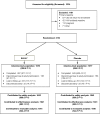SAVVY vaginal gel (C31G) for prevention of HIV infection: a randomized controlled trial in Nigeria
- PMID: 18213382
- PMCID: PMC2190795
- DOI: 10.1371/journal.pone.0001474
SAVVY vaginal gel (C31G) for prevention of HIV infection: a randomized controlled trial in Nigeria
Abstract
Background: The objective of this trial was to determine the effectiveness of 1.0% C31G (SAVVY) in preventing male-to-female vaginal transmission of HIV infection among women at high risk.
Methodology/principal findings: This was a Phase 3, double-blind, randomized, placebo-controlled trial. Participants made up to 12 monthly follow-up visits for HIV testing, adverse event reporting, and study product supply. The study was conducted between September 2004 and December 2006 in Lagos and Ibadan, Nigeria, where we enrolled 2153 HIV-negative women at high risk of HIV infection. Participants were randomized 1 ratio 1 to SAVVY or placebo. The effectiveness endpoint was incidence of HIV infection as indicated by detection of HIV antibodies in oral mucosal transudate (rapid test) or blood (ELISA), and confirmed by Western blot or PCR testing. We observed 33 seroconversions (21 in the SAVVY group, 12 in the placebo group). The Kaplan-Meier estimates of the cumulative probability of HIV infection at 12 months were 0.028 in the SAVVY group and 0.015 in the placebo group (2-sided p-value for the log-rank test of treatment effect 0.121). The point estimate of the hazard ratio was 1.7 for SAVVY versus placebo (95% confidence interval 0.9, 3.5). Because of lower-than-expected HIV incidence, we did not observe the required number of HIV infections (66) for adequate power to detect an effect of SAVVY. Follow-up frequencies of adverse events, reproductive tract adverse events, abnormal pelvic examination findings, chlamydial infections and vaginal infections were similar in the study arms. No serious adverse event was attributable to SAVVY use.
Conclusions/significance: SAVVY did not reduce the incidence of HIV infection. Although the hazard ratio was higher in the SAVVY than the placebo group, we cannot conclude that there was a harmful treatment effect of SAVVY.
Trial registration: ClinicalTrials.gov NCT00130078.
Conflict of interest statement
Figures
References
-
- Moher D, Schulz KF, Altman DG. The CONSORT statement: revised recommendations for improving the quality of reports of parallel-group randomised trials. Lancet. 2001;357:1191–1194. - PubMed
-
- Report on the Global AIDS Epidemic (2006) Geneva, Switzerland: Joint United Nations Programme on HIV/AIDS;
-
- Steiner MJ, Cates W., Jr Condoms and sexually transmitted infections. N Engl J Med. 2006;354:2642–2643. - PubMed
-
- Balzarini J, Van Damme L. Microbicide drug candidates to prevent HIV infection. Lancet. 2007;369:787–797. - PubMed
-
- Wilkinson D, Tholandi M, Ramjee G, Rutherford GW. Nonoxynol-9 spermicide for prevention of vaginally acquired HIV and other sexually transmitted infections: systematic review and meta-analysis of randomized controlled trials including more than 5000 women. Lancet Infect Dis. 2002;2:613–617. - PubMed
Publication types
MeSH terms
Substances
Associated data
LinkOut - more resources
Full Text Sources
Other Literature Sources
Medical


